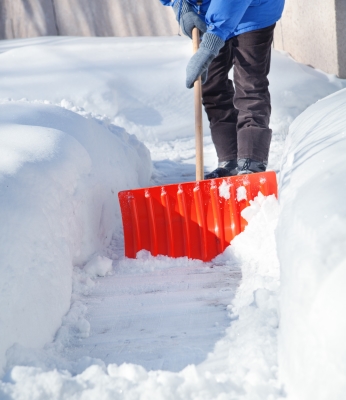Shovel smarter, not harder: protect your back this winter
With winter storm warnings in the forecast, snow-covered driveways and icy sidewalks are inevitable. While clearing snow may be unavoidable, throwing your back out doesn’t have to be. Taking a few precautions can help prevent injury and make the job easier.
“Shoveling snow can be a great way to stay active,” said Dr. Richard Jermyn, dean of Rowan-Virtua School of Osteopathic Medicine. “But if you’re not using proper form, it can put unnecessary strain on your lower back and lead to pain or injury.”
How to protect your back while shoveling snow
To keep your back safe and minimize fatigue, follow these snow removal tips:
- Warm up first. Start with a few minutes of gentle stretching. Slowly bend forward and backward at the waist to loosen up your back muscles before heading outside.
- Stay hydrated. Cold weather can be deceiving—you may not feel as thirsty, but your body still needs water to keep muscles functioning properly and prevent cramping. Drink water before, during and after shoveling.
- Use the right shovel. Choose a lightweight, ergonomic shovel with a curved handle to reduce bending and strain. A smaller blade prevents lifting too much snow at once.
- Push snow instead of lifting. Whenever possible, push the snow to the side rather than lifting it. This reduces stress on your back and shoulders.
- Lift with your legs, not your back. If you must lift, squat with your knees bent, keep your back straight and use your legs to power the movement.
- Keep loads light. Wet, heavy snow can weigh more than 20 pounds per shovelful. Instead of overloading the shovel, take smaller scoops to ease the strain.
- Switch sides. Alternate which hand is on top of the shovel handle to balance the workload on your muscles.
- Take frequent breaks. Every 15 to 20 minutes, stand up straight, stretch your lower back and rest for a moment before continuing.
- Dress for the cold. Wear layers, insulated gloves and waterproof boots with good traction to stay warm and prevent slips.
What to do if you injure your back shoveling snow
Even with good technique, shoveling can leave muscles sore. If you experience discomfort:
- Apply ice to sore areas for 10 to 20 minutes within the first 48 hours to reduce swelling.
- After 48 hours, use heat or alternate between heat and ice to relieve stiffness.
- Rest and avoid heaving lifting for a few days to allow muscles to recover.
- If pain persists for more than a week, worsens when walking or standing, or radiates down your legs, consult a doctor.
How to prevent frostbite while shoveling snow
Winter injuries aren’t just limited to back pain. Dr. Jermyn warns that frostbite can occur quickly, especially when temperatures drop or clothing gets wet. Hands, feet and exposed skin are most at risk.
To avoid frostbite:
- Wear insulated gloves, thick socks and a hat that covers your ears.
- Dress in layers, with a moisture-wicking base layer to stay dry.
- Take regular breaks indoors to warm up.
- If you experience numbness, tingling or skin turning red, blue or white - head indoors immediately and warm up gradually.
By shoveling smart and taking care of your body, you can tackle winter storms without the pain. Stay safe, stay warm and keep that driveway clear!
Schedule an appointment with Rowan-Virtua NMI
Find a location near you and book an appointment with a NeuroMusculoskeletal Institute doctor by visiting our website.
